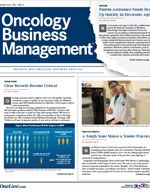Mobile Screening Draws a Crowd
One group of oncologists has found a way to generate more business while at the same time addressing the unwillingness of people to come for screening.
OncLive Chairman,
Mike Hennessy
Louisiana has high cancer mortality rates, but for a long time people naturally assumed it had something to do with the lifestyles and exposure to sunlight of the people who lived there. Now, officials are looking at something else as the potential culprit: low screening rates.
One group of oncologists has found a way to generate more business while at the same time addressing the unwillingness of people to come for screening.
The Mary Bird Perkins Our Lady of the Lake Cancer Center in Baton Rouge has been running a mobile screening unit that at first was taken out to impoverished neighborhoods where the need for screening was perceived to be highest. They then discovered that, parked in company lots and in more affluent parts of town, the mobile unit would draw people out of their office buildings who wouldn’t otherwise take the time to get screened for cancer. These were people who had insurance but weren’t following guidelines for getting screened.
The Mary Bird Perkins story is an interesting lesson about a business-building idea that was discovered through serendipity. It’s also a story of how simple solutions can often solve complex problems—for example, answering the need for cancer checkups by taking the screening directly to the neighborhoods that need it. It’s our practice profile story this month by Andrew Smith. Be sure not to miss it. It’s on page 40.
It’s been an especially newsy month in the oncology practice community. The Community Oncology Alliance (COA) gave us an update on their semi-annual studies of independent practice mergers and financial struggles. What we learned was that the trend toward consolidation and hospital acquisition may have softened a bit, but it’s still going strong. Hundreds of practices have experienced financial struggles at one time or another during the past eight years, 380 have closed, and 609 have formed alliances with or been acquired by hospitals, according to the report. The statistics may give dimension to the problem of running independent businesses these days, but they may not tell hard-working oncology practice administrators anything they don’t already know about modern-day difficulties of making it in this profession.
The creative steps and determination needed to adapt to the new demands on practices are not for the faint-hearted. Just ask Steven D’Amato of New England Cancer Specialists, who talked about cultural fallout at the Institute for Clinical Immuno-Oncology National Conference (ICLIO) in September. When his practice switched over to the Come Home model, the longer hours and patient-centric style of care were simply too radical for many of his workers. Fifty of them either quit or had to be let go. It begs the question, What’s going to happen when the Oncology Care Model starts to engage? D’Amato describes it as “Come Home on steroids.” Read our coverage of what D’Amato and other practice administrators had to say at the ICLIO meeting. Starts on page 22.
CMS also delivered its Final Rule on the Medicare Access and CHIP Reauthorization Act (MACRA). If practice managers are saying the value proposition is a tough rubric to follow, CMS appears to be listening. The Final Rule reaffirms the 2017 transition year as a period during which practices can go at their own pace. It also eases requirements and defines support for small and rural practices that were expected to have the most difficulty with MACRA. At the same time, CMS underscores its intent to continue marching forward. Read about this, and much more, in November’s Oncology Business ManagementTM.




